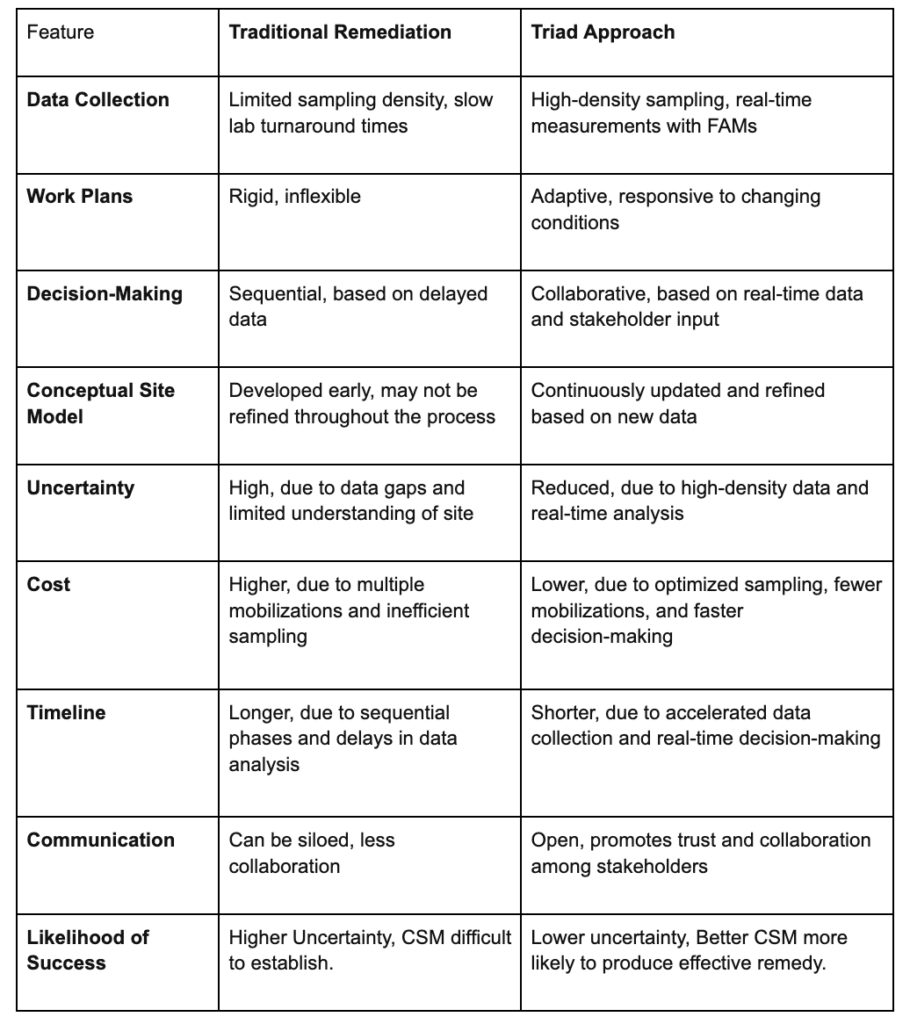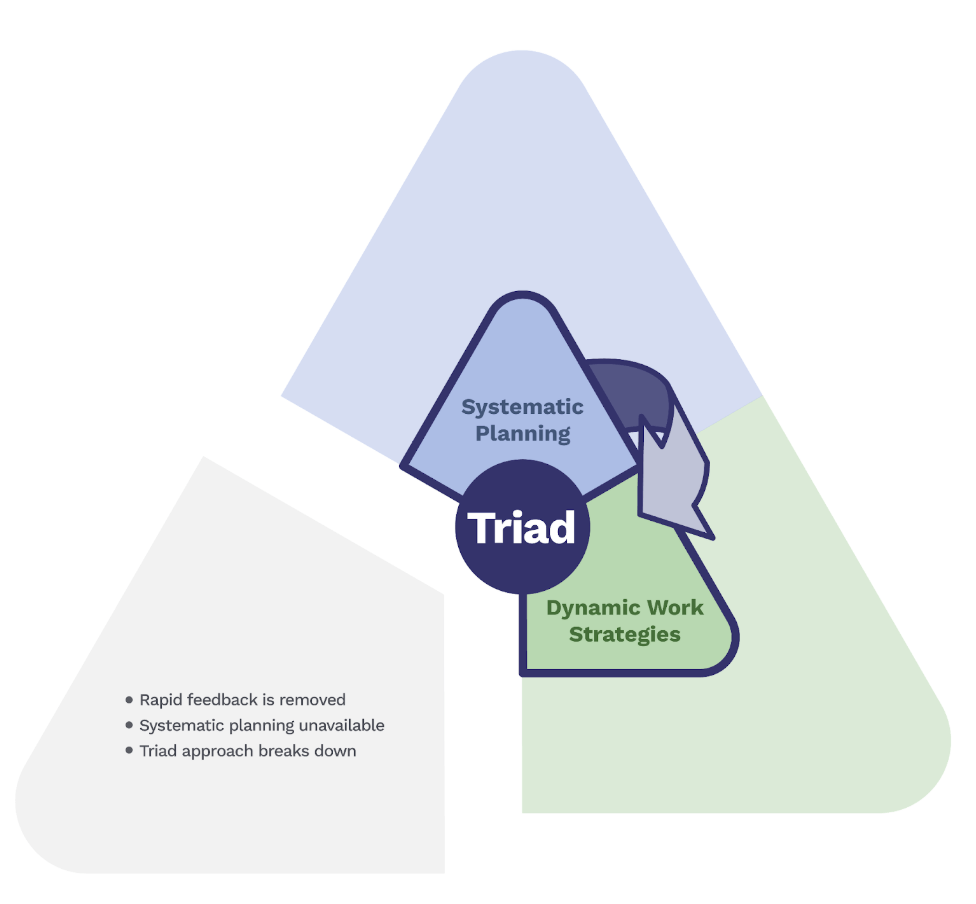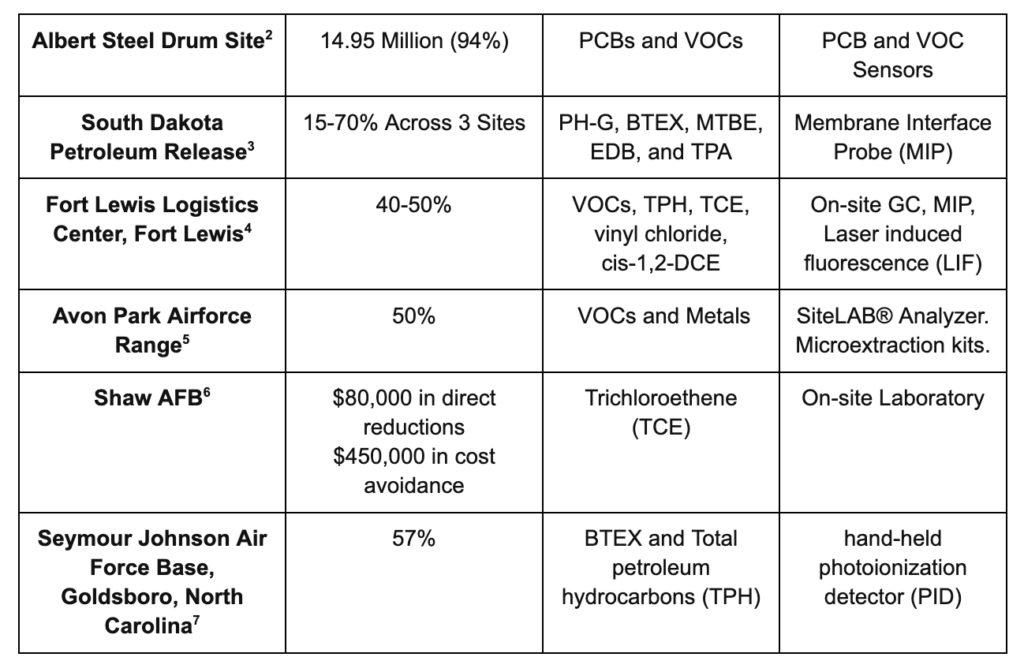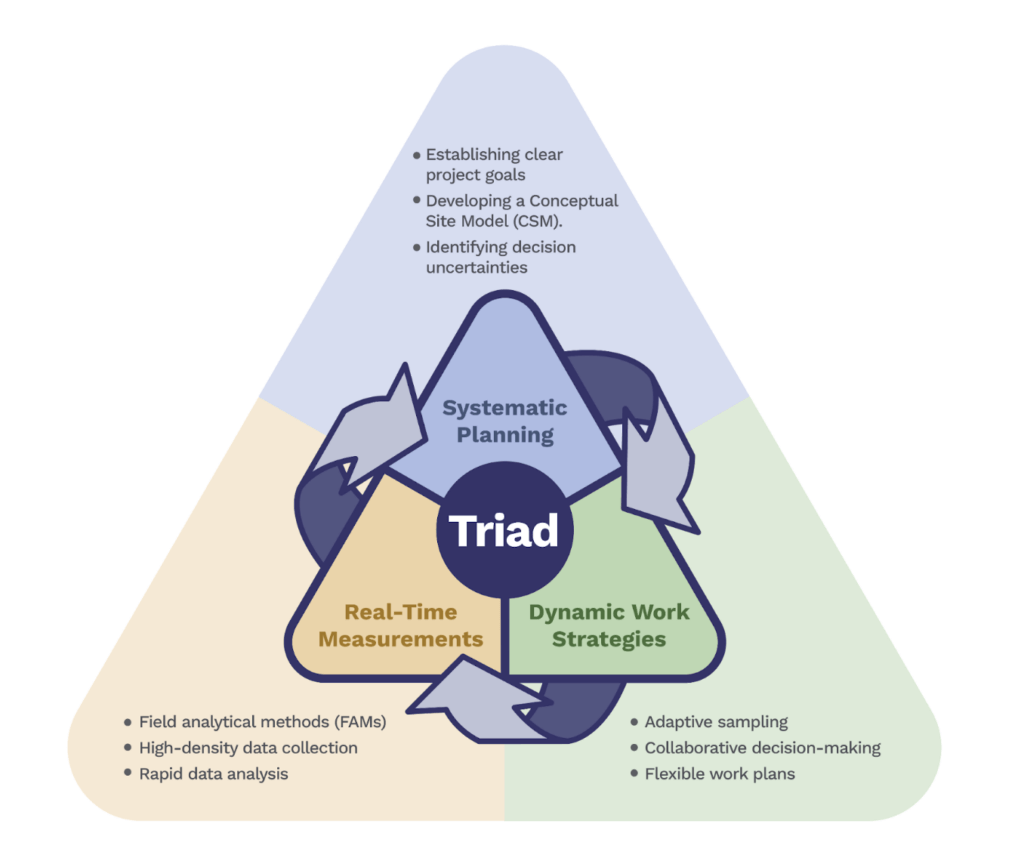Today’s PFAS investigation and remediation often involves multiple phases of investigation, analysis, and planning. Experts rely on third party laboratory analysis for PFAS testing, which can lead to prolonged timelines, escalating costs, and persistent uncertainties.
The EPA’s Triad Approach offers a dynamic, data-driven alternative that streamlines investigation and remediation and achieves more effective outcomes. By integrating systematic planning, dynamic work strategies, and real-time measurements, the Triad Approach empowers stakeholders to make informed decisions, reduce uncertainties, and accelerate project completion.
Traditional Investigation and Remediation: A Phased Approach
Traditional approaches are often used when a remedial market is in its early stages for an emerging contaminant. At the beginning of this evolution, such as with PFAS, stakeholders are becoming familiar with the contaminant and how it behaves in various environments. In some cases, such as with PFAS, experts use existing best practices to bridge the gap while technology catches up with a viable solution. In this situation, innovation leads the way to better practices.
Traditional site investigation and remediation follows an iterative, multi-deployment approach to fully characterize a site:

While effective, this approach has multiple limitations:
- Time-consuming data collection: Traditional sampling methods and analysis often require lengthy laboratory turnaround times, delaying decision-making and progress.
- Data gaps and uncertainties: Limited sampling density can result in an incomplete understanding of site conditions, leading to inaccurate conceptual site models and ineffective remedies.
- Multiple mobilizations: The need for additional data often requires multiple site visits, increasing costs and prolonged timelines.
- Inflexible work plans: Traditional work plans are often rigid and not equipped to adapt to a PFAS site’s changing conditions or new information

The Triad Approach: A Dynamic, Data-Driven Alternative
The origin of the Triad Approach can be traced to the early 1990s, when the Department of Energy (DOE) articulated the concepts of the triad approach as Expedited Site Characterization (ESC).
Since then, numerous entities including the Interstate Technology and Regulatory Council (ITRC) in collaboration with the DOE, Department of Defense (DoD), and Environmental Protection Agency (EPA), have developed Triad Approach guidance. The Triad Approach modernizes the environmental restoration process; integrating scientific and societal factors to better address environmental impacts. The Triad Approach achieves this by emphasizing thorough investigation planning (systematic project planning), increased adaptability in fieldwork (dynamic work strategies), and the use of real-time measurement technologies, including field-generated data.
At its core, the Triad Approach focuses on understanding and managing uncertainties that impact decision-making. By leveraging technological, scientific, and procedural advancements, it enhances both quality and cost efficiency of investigation and remediation.
The Triad Approach optimizes site remediation through three core elements:
In concert, the three pillars of the Triad Approach provide a comprehensive methodology to remediation that is time and cost effective. The Triad Approach has been successfully applied to a variety of site investigation and remediation projects, including those involving mixed chlorinated solvents, petroleum releases, and other contaminants

Key Benefits of the Triad Approach for Investigation and Remediation

Why aren’t we Following this Approach for PFAS?
The Triad Approach is an excellent tool for any investigation or remediation project. Consultants are highly trained and familiar with dynamic remediation approaches. So what makes the Triad approach unavailable for PFAS remediation?

Like a three-legged stool, the Triad Approach fails when it is missing one of the legs.
PFAS analytical tools are trailing behind investigation needs. Real-time measurement options have not been available in the market, until recently. This has forced consultants to follow the traditional approach, “Looking in the rear-view mirror” to make decisions, and stifling progress. Prolonging project timeline at significant costs.
PFAS investigation and remediation is a rapidly growing industry. Without real-time measurement capabilities the cost to characterize and remediate PFAS impacts will balloon to exceed global GDP. Consultants will need to resort to traditional processes and site owners will be burdened with increasing costs and unwieldy schedules. Real-time assessment increases the certainty of a successful and cost-effective investigation. This creates both direct cost savings and cost avoidance that would not have been realized without real-time measurement.
The Triad Approach has been used for similar problems like polychlorinated biphenyl (PCBs), volatile organic compounds (VOCs), and polycyclic aromatic hydrocarbons (PAHs) to deliver cost effective projects. It is now time to leverage it for PFAS.

Quantitative Evidence of the Triad Approach’s Value
The Triad Approach is only now being unlocked for PFAS remediation. This means we have to look at non-PFAS examples to see the value of a dynamic investigation and remediation approach.
Real-world examples of the cost savings of utilizing the Triad Approach for Investigation and Remediation


PFAS Test Kits support cost effective PFAS Remediation
Migrating to the Triad Approach for PFAS would represent a significant advancement in site investigation and remediation. By embracing systematic planning, dynamic work strategies, and the missing link of real-time measurements, the Triad Approach empowers stakeholders to optimize their investigation and remediation workflows.

With rapid advancements in the real-time analytical space, PFAS investigation and remediation can now be completed with real-time data and dynamic approaches. Environmental consultants and site owners no longer have to be in the dark when deploying to a PFAS site. As the industry continues to seek more efficient and sustainable PFAS investigation and remediation solutions, the Triad Approach offers a proven framework for success. Real-time PFAS analysis is now available to support dynamic approaches.
Check out how FRED-PFAS is revolutionizing PFAS investigation and remediation.
References
- Characterization of volatile organic compounds (VOC) and polychlorinated biphenyls (PCB) using immunoassay PCB test kits and field gas chromatography (GC) analysis at the Albert Steel Drum Site, Newark, New Jersey. Triad Project Profile: Characterization of Volatile Organic Compounds (VOC) and Polychlorinated Biphenyls (PCB) Using Immunoassay PCB Test Kits and Field Gas Chromatography (GC) Analysis at the Albert Steel Drum Site, Newark, New Jersey. (n.d.). https://triadcentral.clu-in.org/user/includes/dsp_profile.cfm?Project_ID=16
- Characterizing a complex TCE groundwater plume, eliminating suspected source areas, and reducing investigation costs for a RCRA RFI at Shaw AFB, SC. Triad Project Profile: Characterizing a Complex TCE Groundwater Plume, Eliminating Suspected Source Areas, and Reducing Investigation Costs for a RCRA RFI at Shaw AFB, SC. (n.d.). https://triadcentral.clu-in.org/user/includes/dsp_profile.cfm?Project_ID=34
- Clu-in: Optimization > triad approach. CLUIN News. (n.d.). https://clu-in.org/optimization/components_triad.cfm#:~:text=There%20are%20three%20elements%20of, conducting%20environmental%20investigation%20and%20remediation
- Crumbling, D. M. (n.d.). Using the Triad approach to improve the cost-effectiveness of hazardous waste site cleanups | US EPA. https://www.epa.gov/remedytech/using-triad-approach-improve-cost-effectiveness-hazardous-waste-site-cleanups
- Expedited site characterization of mixed chlorinated solvents and petroleum dense non-aqueous phase liquid (DNAPL) using multiple investigative techniques in conjunction with mobile and Fixed Labs at Fort Lewis Logistics Center, Fort Lewis, WA. Triad Project Profile: Expedited Site Characterization of Mixed Chlorinated Solvents and Petroleum Dense Non-Aqueous Phase Liquid (DNAPL) Using Multiple Investigative Techniques in Conjunction with Mobile and Fixed Labs at Fort Lewis Logistics Center, Fort Lewis, WA. (n.d.). https://triadcentral.clu-in.org/user/includes/dsp_profile.cfm?Project_ID=13
- Rapid characterization and management of decision uncertainty using membrane interface probe technology at multiple petroleum release sites, South Dakota. Triad Project Profile: Rapid Characterization and Management of Decision Uncertainty Using Membrane Interface Probe Technology at Multiple Petroleum Release Sites, South Dakota. (n.d.). https://triadcentral.clu-in.org/user/includes/dsp_profile.cfm?Project_ID=19
- Use of fast turnaround laboratory analysis and field test kits to delineate a broad range of contaminants in soil and groundwater at four sites in a single mobilization, Avon Park Air Force Range, Florida. Triad Project Profile: Use of Fast Turnaround Laboratory Analysis and Field Test Kits to Delineate a Broad Range of Contaminants in Soil and Groundwater at Four Sites in a Single Mobilization, Avon Park Air Force Range, Florida. (n.d.). https://triadcentral.clu-in.org/user/includes/dsp_profile.cfm?Project_ID=22
- Wangensteen, M. (n.d.). The Use of Future First Planning, the Triad, and Performance-Based Contracting to Accelerate Site Closure at Seymour Johnson AFB. https://apps.dtic.mil/sti/pdfs/AD1041749.pdf

